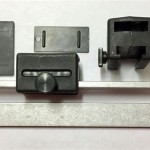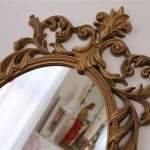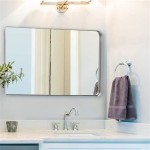How To Frame A Mirror With Tile
Framing a mirror with tile elevates its appearance, transforming it from a simple reflective surface into a decorative focal point. This project can be accomplished with various tile types, offering homeowners a chance to personalize their spaces. Whether aiming for a sleek, modern look or a rustic, handcrafted aesthetic, tiling a mirror frame is an achievable DIY endeavor.
Choosing the Right Tiles
Tile selection significantly impacts the final outcome. Consider the mirror's size and the desired style. Smaller mosaic tiles create intricate patterns, while larger format tiles provide a cleaner, more contemporary feel. Glass tiles offer a reflective quality, enhancing the mirror's luminosity. Ceramic and porcelain tiles provide durability and a wide range of colors and textures, accommodating various design schemes. Natural stone tiles, like marble or travertine, contribute a luxurious touch but require specific adhesives and sealants.
Gathering Necessary Materials and Tools
Proper preparation streamlines the tiling process. Essential materials include: the chosen tiles, thin-set mortar, grout, spacers, a notched trowel, a grout float, a tile cutter or wet saw (depending on tile type), a level, measuring tape, masking tape, a bucket, a sponge, and safety glasses. Choosing the correct thin-set and grout color enhances the overall aesthetic. White thin-set is versatile, while gray is suitable for darker tiles. Grout color should complement the chosen tiles, either blending seamlessly or providing a contrasting accent.
Preparing the Mirror and Surface
Before beginning the tiling process, ensure the mirror's surface is clean and free of dust or debris. Clean the mirror with a glass cleaner and thoroughly dry it. If the mirror has an existing frame, carefully remove it. Cover the mirror's reflective surface with masking tape to protect it from scratches and mortar residue. A drop cloth or newspaper beneath the mirror prevents messes on the surrounding area.
Applying the Thin-Set Mortar
Using a notched trowel, apply a thin, even layer of thin-set mortar to the mirror's frame area, starting from the center and working outwards. The size of the notches on the trowel depends on the size of the tiles being used. Larger tiles require larger notches. Apply only enough thin-set to cover an area that can be tiled within the mortar's working time, usually around 20 minutes. Avoid applying too much thin-set, which can squeeze out between the tiles and create a messy appearance.
Placing the Tiles
Carefully place the first tile onto the thin-set, pressing firmly to ensure good adhesion. Use spacers between each tile to maintain consistent grout lines. Regularly check the alignment of the tiles with a level, adjusting as needed. Maintaining consistent spacing and alignment is crucial for a professional-looking finished product. For curved mirrors, smaller tiles or mosaic sheets offer greater flexibility in conforming to the curved surface.
Cutting Tiles for Edges and Corners
Most mirror frames require tile cutting to fit the edges and corners. Depending on the type of tile, use a tile cutter or wet saw for precise cuts. For intricate cuts around curved edges, a tile nipper might be necessary. Always wear safety glasses when using these tools. Measure accurately to minimize waste and ensure a perfect fit.
Grouting and Cleaning
After the thin-set has cured for at least 24 hours (refer to the manufacturer's instructions), remove the spacers and begin grouting. Mix the grout according to the manufacturer's instructions to achieve the desired consistency. Apply the grout using a grout float, pressing it diagonally into the grout lines to fill them completely. Remove excess grout with the edge of the float. After the grout has partially set (approximately 15-20 minutes), use a damp sponge to clean the tile surface, removing any grout haze. Rinse the sponge frequently in clean water. Allow the grout to fully cure for the recommended time before using or cleaning the mirror.
Sealing the Grout (Optional)
For added protection, particularly in wet areas like bathrooms, consider sealing the grout lines. Grout sealant helps prevent staining and moisture penetration, prolonging the life and beauty of the tiled mirror frame. Apply the sealant according to the manufacturer's instructions. This step is particularly important for porous tile types like natural stone.

How To Make A Custom Tiled Mirror The Stonybrook House

How To Decorate A Mirror With Tile Sand And Sisal

How To Decorate A Mirror With Tile Sand And Sisal

How To Mosaic Tile A Mirror Caffeine And Cabernet

How To Make A Custom Tiled Mirror Bathroom Mirrors Diy Tile Frame

How To Mosaic Tile A Mirror Caffeine And Cabernet

How To Make A Custom Tiled Mirror The Stonybrook House

How To Frame A Mirror With Tile

No Grout Mosaic Tile Mirror The Diy Village

How To Frame A Bathroom Mirror With Mosaic Tile Hometalk








